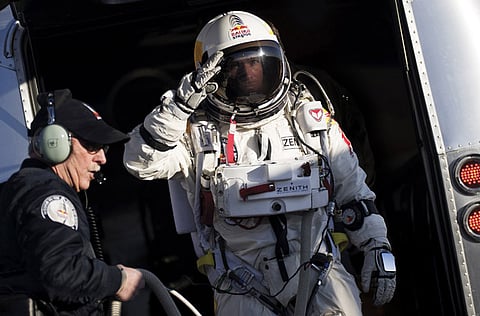Fearless Felix to attempt the leap of his life
Austrian extreme athlete Felix could be the first skydiver to break the sound barrier

ROSWELL, New Mexico: Austrian skydiver and extreme athlete Felix Baumgartner hopes to take the leap of his life on Tuesday, attempting the highest, fastest free fall in history.
If he survives, the man dubbed “Fearless Felix” could be the first skydiver to break the sound barrier. If he doesn’t, a tragic fall could be live-streamed on the Internet for the world to see.
Rigged with cameras, the 43-year-old former military parachutist is scheduled to jump from a balloon-hoisted capsule 23 miles (37 kilometers) near Roswell on Tuesday morning. He wants to break the record set in 1960 by Joe Kittinger, who jumped from an open gondola at an altitude of 19.5 miles (31 kilometers). Kittinger’s speed of 614 mph (988 kph) was just shy of breaking the sound barrier at that height.
Baumgartner, who has been preparing for the jump for five years, has made two practice runs from the Roswell area, from 15 miles (24 kilometers) high in March and 18 miles (28.97 kilometers) in July.
And while he and his team of experts recognize the worst-case scenarios - including “boiling” blood and exploding lungs - they have confidence in their built-in solutions. Those solutions are something NASA is watching closely. The space agency is interested in the potential for escape systems on future rocket ships.
Baumgartner’s top medical man is Dr. Jonathan Clark, a former NASA flight surgeon whose wife, astronaut Laurel Clark, died in the space shuttle Columbia accident in 2003. Clark is dedicated to improving astronauts’ chances of survival in a high-altitude disaster.
The No. 1 fear is a breach of Baumgartner’s suit, which could cause potentially lethal bubbles to form in his bodily fluids, a condition known as boiling blood. There are also risks he could spin out of control, causing other problems.
This death-defying venture is being sponsored by energy drink maker, Red Bull, which has funded other extreme athletic events. The project’s team of experts has a plan for almost every contingency. The spacesuit and capsule were tested in the early skydiving practice runs. The company won’t say how much the project, called Stratos for stratosphere, is costing.
But whether Baumgartner can make what he vows will be his final jump depends on the weather. A cold front that brought winds to the area this weekend prompted the team to move the planned Monday jump to Tuesday.
Baumgartner’s team remained optimistic about getting the mission off the ground.
“From what we are looking at so far, we are on schedule (for Tuesday),” meteorologist Don Day said at a media briefing Sunday.
Weather permitting, Baumgartner will be lifted into the stratosphere around 7 a.m. MDT (1300 GMT) by a helium balloon that will stretch 55 stories high. Once he reaches his target altitude, he will open the hatch of his capsule and make a gentle, bunny-style jump. Any contact with the capsule on his exit could break open the pressurized suit that will protect him from temperatures as low as minus 70 and a lack of oxygen. He hopes to reach a speed of 690 mph (1,110 kph) to break the sound barrier.
Baumgartner, who has made more than 2,500 jumps from planes, helicopters, landmarks and skyscrapers over the past 25 years, promises this jump will be his last.
He says he plans to settle down with his girlfriend and fly helicopters on mountain rescue and firefighting missions in the U.S. and Austria.
Sign up for the Daily Briefing
Get the latest news and updates straight to your inbox



